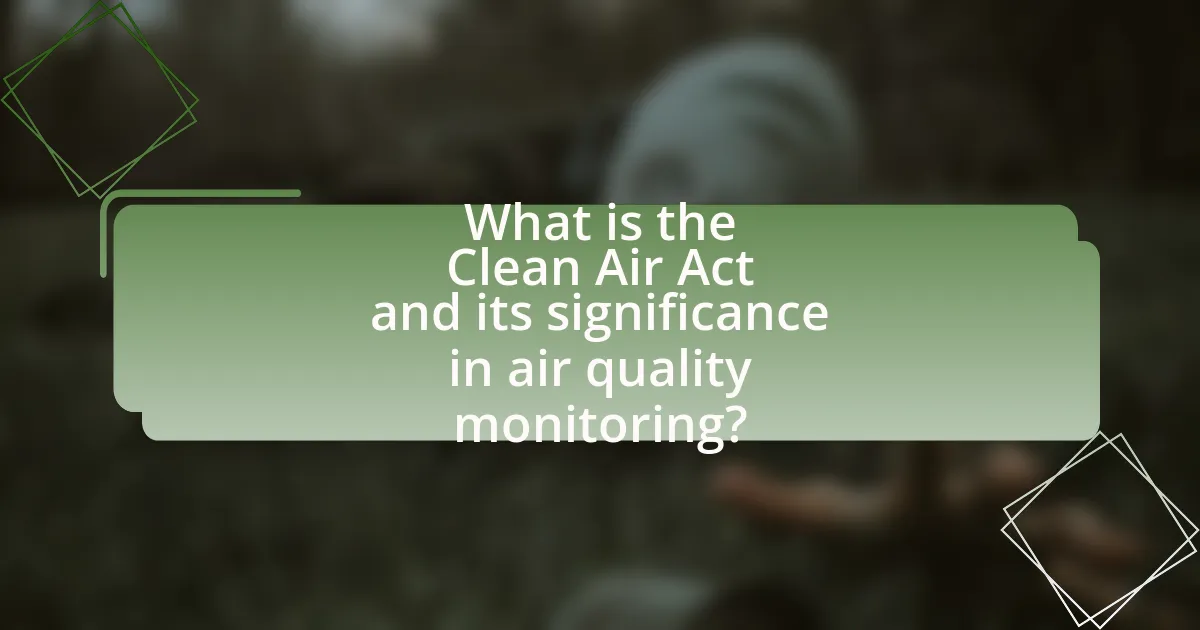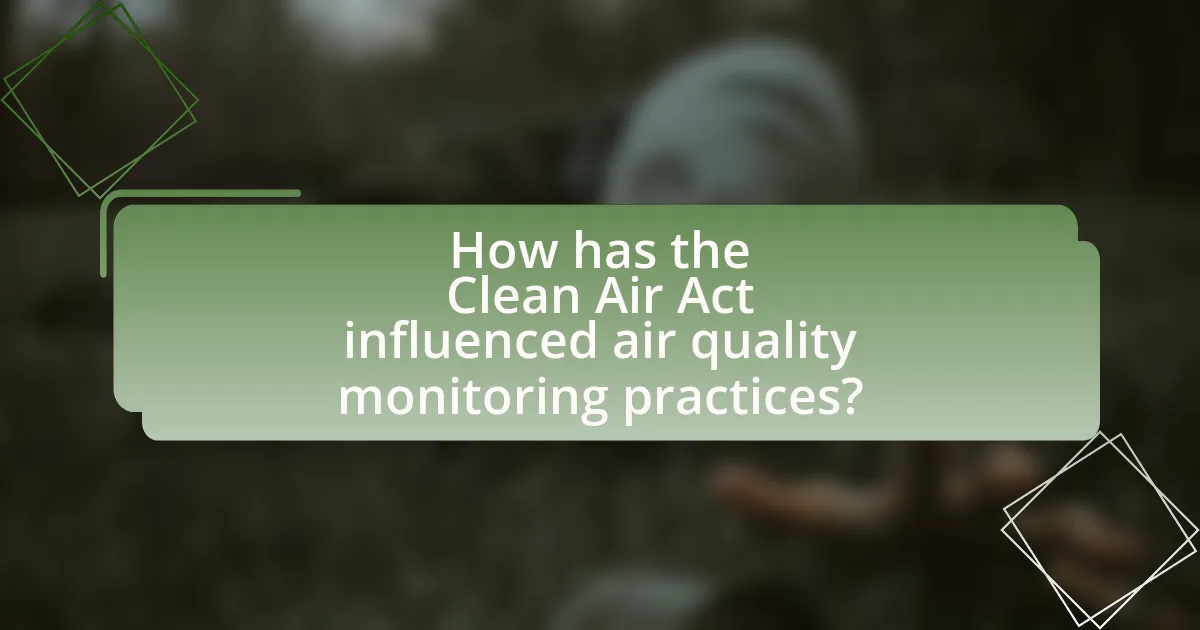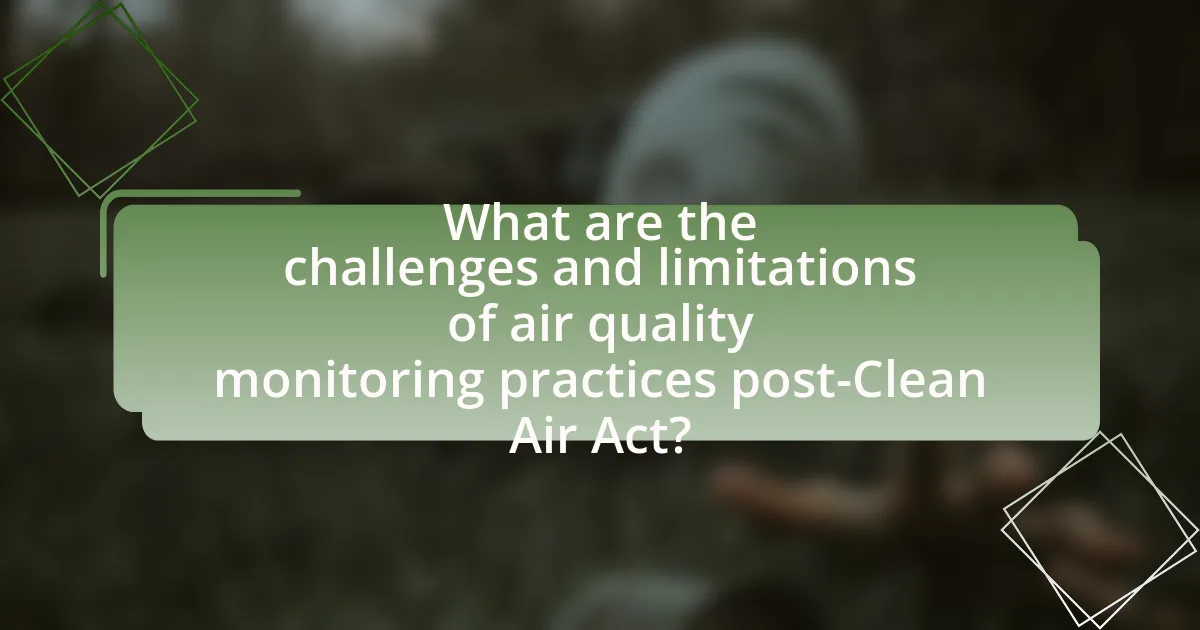The Clean Air Act, enacted in 1970, is a pivotal federal law that regulates air emissions to safeguard public health and the environment. This article examines the Act’s significance in air quality monitoring, detailing its origins, key amendments, and the establishment of National Ambient Air Quality Standards (NAAQS). It highlights the improvements in air quality since the Act’s implementation, the role of the Environmental Protection Agency (EPA) in monitoring, and the challenges faced in maintaining accurate air quality data. Additionally, the article discusses innovative technologies and best practices that can enhance future air quality monitoring efforts.
What is the Clean Air Act and its significance in air quality monitoring?

The Clean Air Act is a comprehensive federal law enacted in 1970 that regulates air emissions from stationary and mobile sources to protect public health and the environment. Its significance in air quality monitoring lies in establishing national air quality standards and requiring states to develop implementation plans to achieve and maintain these standards. The Act mandates regular monitoring and reporting of air quality data, which has led to significant improvements in air quality across the United States. For instance, the Environmental Protection Agency (EPA) reports that since the Act’s implementation, common air pollutants have decreased by over 70% while the economy has continued to grow, demonstrating the effectiveness of the Clean Air Act in promoting both public health and economic stability.
How did the Clean Air Act originate and evolve over time?
The Clean Air Act originated in 1963 as the first federal legislation aimed at controlling air pollution in the United States. Initially, it provided federal funding for state and local programs to improve air quality but lacked stringent regulatory measures. Over time, the Act evolved significantly, particularly with major amendments in 1970, 1977, and 1990, which introduced more comprehensive regulations, established National Ambient Air Quality Standards (NAAQS), and expanded the federal government’s authority to enforce air quality standards. These amendments reflected growing public concern about air pollution and its health impacts, leading to more robust air quality monitoring practices and the establishment of the Environmental Protection Agency (EPA) to oversee compliance and enforcement.
What were the key amendments made to the Clean Air Act?
The key amendments made to the Clean Air Act include the 1970 amendment, which established National Ambient Air Quality Standards (NAAQS), and the 1990 amendment, which introduced provisions for acid rain control, ozone layer protection, and toxic air pollutants. The 1970 amendment mandated states to develop State Implementation Plans (SIPs) to achieve and maintain NAAQS, significantly enhancing air quality monitoring practices. The 1990 amendment further strengthened regulatory measures by requiring the Environmental Protection Agency (EPA) to address hazardous air pollutants and implement a cap-and-trade program for sulfur dioxide emissions, thereby improving air quality management and monitoring.
How has the public perception of air quality changed since the Act’s implementation?
Since the implementation of the Clean Air Act, public perception of air quality has significantly improved. Surveys indicate that awareness of air pollution issues has increased, with many individuals recognizing the importance of clean air for health and environmental sustainability. For instance, a 2020 Gallup poll showed that 63% of Americans are concerned about air pollution, reflecting a heightened public consciousness about air quality issues since the Act’s enactment in 1970. This shift in perception is supported by the visible improvements in air quality metrics, such as a 74% reduction in six common air pollutants from 1970 to 2020, as reported by the Environmental Protection Agency.
What are the primary objectives of the Clean Air Act?
The primary objectives of the Clean Air Act are to regulate air emissions from stationary and mobile sources, establish National Ambient Air Quality Standards (NAAQS), and ensure public health and environmental protection. The Act aims to reduce air pollution and improve air quality across the United States by setting limits on the concentration of harmful pollutants. Since its enactment in 1970, the Clean Air Act has led to significant reductions in pollutants such as sulfur dioxide, nitrogen oxides, and particulate matter, contributing to improved public health outcomes and environmental quality.
How does the Act aim to reduce air pollution levels?
The Act aims to reduce air pollution levels by establishing national air quality standards and regulating emissions from various sources. Specifically, it mandates the Environmental Protection Agency to set limits on pollutants such as sulfur dioxide, nitrogen oxides, and particulate matter, which are known to harm public health and the environment. The Act also requires states to develop implementation plans to achieve and maintain these standards, thereby promoting cleaner air through systematic monitoring and enforcement of air quality regulations.
What role does the Act play in protecting public health?
The Clean Air Act plays a crucial role in protecting public health by establishing national air quality standards aimed at reducing air pollution. These standards are designed to limit harmful pollutants, such as particulate matter and ozone, which are known to cause respiratory diseases, cardiovascular problems, and other health issues. The Act mandates regular monitoring and assessment of air quality, ensuring that states implement measures to meet these standards, thereby directly contributing to improved public health outcomes. For instance, studies have shown that the implementation of the Clean Air Act has led to significant reductions in air pollution levels, resulting in thousands of avoided premature deaths and reduced healthcare costs associated with air quality-related illnesses.
How has the Clean Air Act influenced air quality monitoring practices?

The Clean Air Act has significantly influenced air quality monitoring practices by establishing regulatory frameworks that require systematic data collection and analysis of air pollutants. This legislation mandates the Environmental Protection Agency (EPA) to set National Ambient Air Quality Standards (NAAQS), which necessitates the development of comprehensive monitoring networks across the United States. As a result, states are required to implement and maintain air quality monitoring stations that provide real-time data on pollutant levels, ensuring compliance with federal standards. The Act has also led to advancements in monitoring technologies and methodologies, enhancing the accuracy and reliability of air quality assessments.
What changes in air quality monitoring were prompted by the Clean Air Act?
The Clean Air Act prompted significant changes in air quality monitoring by establishing national air quality standards and requiring states to implement monitoring systems to assess compliance. This legislation mandated the development of a comprehensive network of air quality monitoring stations across the United States, which facilitated the collection of data on pollutants such as sulfur dioxide, nitrogen oxides, and particulate matter. Additionally, the Act led to the creation of the National Ambient Air Quality Standards (NAAQS), which set specific limits for these pollutants, ensuring that monitoring efforts were aligned with public health and environmental protection goals. These changes enhanced the ability to track air quality trends and informed regulatory actions to improve air quality nationwide.
How did the Act establish standards for air quality monitoring?
The Clean Air Act established standards for air quality monitoring by mandating the Environmental Protection Agency (EPA) to set National Ambient Air Quality Standards (NAAQS) for harmful pollutants. These standards are designed to protect public health and the environment, ensuring that air quality is regularly assessed and maintained. The Act requires states to develop State Implementation Plans (SIPs) that outline how they will achieve and maintain these standards, thereby creating a structured framework for air quality monitoring and enforcement.
What technologies were developed as a result of the Clean Air Act?
The Clean Air Act led to the development of several key technologies aimed at improving air quality monitoring and pollution control. Notable advancements include continuous emissions monitoring systems (CEMS), which provide real-time data on pollutant emissions from industrial sources, and low-NOx burners, designed to reduce nitrogen oxide emissions from combustion processes. Additionally, the Act spurred the creation of advanced air quality modeling software, enabling better prediction and analysis of air pollution dispersion. These technologies have been essential in helping industries comply with regulatory standards and in enhancing overall air quality management efforts.
How do federal and state agencies implement air quality monitoring under the Clean Air Act?
Federal and state agencies implement air quality monitoring under the Clean Air Act by establishing a network of monitoring stations that measure pollutants in the air. The Environmental Protection Agency (EPA) sets national air quality standards and provides guidelines for monitoring methods, while state agencies are responsible for collecting data and ensuring compliance with these standards.
For instance, the EPA requires states to develop State Implementation Plans (SIPs) that outline how they will monitor air quality and achieve compliance with federal standards. These plans include details on the location of monitoring stations, the types of pollutants to be measured, and the frequency of data collection. Additionally, the EPA conducts regular assessments and audits of state monitoring programs to ensure accuracy and reliability of the data collected.
This structured approach ensures that air quality monitoring is consistent across the country and that states are held accountable for maintaining air quality standards, ultimately contributing to improved public health and environmental protection.
What are the roles of the Environmental Protection Agency (EPA) in monitoring air quality?
The Environmental Protection Agency (EPA) plays a crucial role in monitoring air quality by establishing and enforcing air quality standards under the Clean Air Act. The EPA sets National Ambient Air Quality Standards (NAAQS) for pollutants considered harmful to public health and the environment, such as particulate matter and ozone. Additionally, the agency conducts air quality assessments through a network of monitoring stations across the United States, collecting data to evaluate compliance with these standards. The EPA also provides guidance and technical support to state and local agencies in their air quality management efforts, ensuring that air quality data is accurate and accessible. This systematic approach to monitoring is essential for protecting public health and improving air quality nationwide.
How do state agencies collaborate with the EPA for effective monitoring?
State agencies collaborate with the EPA for effective monitoring through data sharing, joint assessments, and compliance oversight. This collaboration is facilitated by the Clean Air Act, which mandates that state agencies develop State Implementation Plans (SIPs) that align with federal standards. The EPA provides technical assistance and guidance to ensure that state monitoring systems meet national requirements. Additionally, state agencies often conduct air quality monitoring and reporting, which is then submitted to the EPA for evaluation, ensuring that both levels of government work together to maintain air quality standards. This partnership enhances the overall effectiveness of air quality monitoring across the United States.
What are the challenges and limitations of air quality monitoring practices post-Clean Air Act?

The challenges and limitations of air quality monitoring practices post-Clean Air Act include insufficient funding, technological limitations, and inconsistent data collection methods. Insufficient funding restricts the ability of agencies to maintain and upgrade monitoring equipment, leading to outdated technology that may not accurately capture current air quality conditions. Technological limitations can hinder the detection of emerging pollutants, as many monitoring systems were designed primarily for traditional pollutants like sulfur dioxide and nitrogen oxides. Additionally, inconsistent data collection methods across different regions can result in gaps in data and make it difficult to compare air quality across jurisdictions, undermining the effectiveness of regulatory measures. These factors collectively impede the ability to effectively monitor and manage air quality in accordance with the goals set forth by the Clean Air Act.
What obstacles do agencies face in maintaining accurate air quality data?
Agencies face several obstacles in maintaining accurate air quality data, including limited funding, outdated monitoring equipment, and inconsistent data reporting standards. Limited funding restricts the ability to invest in advanced technology and personnel training, which are essential for accurate data collection. Outdated monitoring equipment can lead to inaccuracies in measurements, as older devices may not meet current standards for precision. Additionally, inconsistent data reporting standards across different jurisdictions can result in discrepancies, making it difficult to compare air quality data reliably. These challenges hinder the effectiveness of air quality monitoring efforts mandated by the Clean Air Act.
How do funding and resource allocation impact monitoring efforts?
Funding and resource allocation significantly influence monitoring efforts by determining the availability of necessary tools, personnel, and technologies. Adequate funding allows for the procurement of advanced monitoring equipment, hiring skilled staff, and implementing comprehensive data collection strategies. For instance, the U.S. Environmental Protection Agency (EPA) reported that increased funding under the Clean Air Act led to enhanced air quality monitoring networks, resulting in more accurate data collection and improved public health outcomes. Conversely, insufficient funding can lead to outdated equipment, reduced monitoring frequency, and gaps in data, ultimately compromising the effectiveness of air quality management initiatives.
What are the limitations of current air quality monitoring technologies?
Current air quality monitoring technologies face several limitations, including high costs, limited spatial coverage, and insufficient real-time data accuracy. High costs restrict widespread deployment, particularly in low-income areas, leading to gaps in monitoring networks. Limited spatial coverage results from the reliance on fixed monitoring stations, which may not capture localized pollution events. Additionally, many technologies struggle with real-time data accuracy due to calibration issues and environmental interferences, which can lead to misleading assessments of air quality. These limitations hinder effective regulatory compliance and public health responses, as highlighted by studies indicating that inadequate monitoring can result in underestimating exposure risks in vulnerable populations.
How can air quality monitoring practices be improved in the future?
Air quality monitoring practices can be improved in the future by integrating advanced sensor technologies and real-time data analytics. The deployment of low-cost, high-accuracy sensors allows for more widespread monitoring, enabling communities to gather localized air quality data. Additionally, utilizing machine learning algorithms can enhance data interpretation, identifying pollution sources and predicting air quality trends. Research indicates that cities employing these technologies have seen significant improvements in air quality management, as evidenced by the successful implementation in cities like Los Angeles, where real-time data has led to more effective regulatory actions.
What innovative technologies could enhance air quality monitoring?
Innovative technologies that could enhance air quality monitoring include low-cost sensors, satellite remote sensing, and artificial intelligence (AI) analytics. Low-cost sensors provide real-time data on pollutants and can be deployed in large networks, improving spatial coverage and data granularity. Satellite remote sensing allows for the monitoring of air quality over vast areas, capturing data on pollutants like nitrogen dioxide and particulate matter from space. AI analytics can process large datasets from various sources, identifying patterns and predicting air quality trends, which aids in timely decision-making. These technologies collectively improve the accuracy, accessibility, and responsiveness of air quality monitoring systems.
How can public engagement and education improve monitoring outcomes?
Public engagement and education can significantly improve monitoring outcomes by fostering community involvement and enhancing awareness of air quality issues. When the public is educated about the importance of air quality monitoring, they are more likely to participate in data collection efforts, report pollution sources, and advocate for better practices. For instance, programs that educate citizens on how to use air quality monitoring tools have been shown to increase the amount of data collected, as seen in initiatives like the Community Air Monitoring Program in California, which resulted in more localized and accurate air quality data. Furthermore, increased public engagement leads to greater accountability for regulatory bodies, as informed citizens can demand transparency and action regarding air quality issues.
What best practices should be adopted for effective air quality monitoring?
Effective air quality monitoring requires the adoption of standardized measurement protocols, the use of calibrated and validated instruments, and the implementation of continuous data collection methods. Standardized protocols ensure consistency and comparability of data across different locations and time periods, which is crucial for regulatory compliance and public health assessments. Calibrated instruments, such as low-cost sensors and reference-grade monitors, provide accurate readings of pollutants, while continuous data collection allows for real-time analysis and timely responses to air quality issues. According to the U.S. Environmental Protection Agency, adherence to these practices enhances the reliability of air quality data, ultimately supporting informed decision-making and effective policy implementation under the Clean Air Act.

Leave a Reply